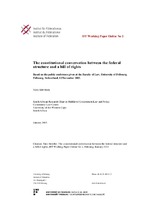| dc.description.abstract | It is often assumed that a constitution speaks with one voice and that all parts are in harmony with each other. Although different provisions can be given higher status than others (as reflected in the more arduous amendment procedures concerning, for example, national values), the general assump-tion is that they are all of equal value. Where provisions are seemingly at odds with one another, such as cases where there are two rights in a bill of rights lead to conflicting outcomes, the deft in-terpreter can nevertheless produce a balanced or harmonious end-result. While this approach is nec-essary for a purposive interpretation of a constitution, it blocks from view a different reality in which parts of the constitution are in constant conversation with each other. A particular instance of this is the conversation between the federal structure and a bill of rights.
Tuning into this conversation is not only pertinent from a theoretical perspective but also has practi-cal consequences. The Community Law Centre at the University of the Western Cape in South Afri-ca, to which I have been attached for the past two decades, has a dual focus: multi-level government and human rights. We have organised ourselves into projects focusing, on the one hand, on local government and federalism, and, on the other, socio-economic rights, gender rights, children’s rights and prisoners’ rights. This dual focus was not by design so much as historical accident. The first director of the Centre, Advocate Dullah Omar, was a leading legal activist in the African National Congress who eventually became the first Minister of Justice in the Mandela cabinet and had played a strong hand in the drafting of the interim Constitution in 1993; his focus was on the structures of government. Other staff members, such as Brigitte Mabandla (who, in the Mbeki cabinet, also be-came a Minister of Justice), were more interested in the Bill of Rights, in particular the rights of women and children. Since then there has been the split in the Centre between the structuralists (fo-cusing on multi-level government) and the normativists (concerned with human rights). | en_US |

